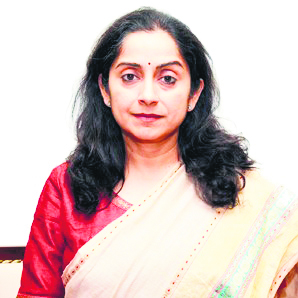‘The story here is not a political one. It is beyond politics. It is a story of India’s growth and development.’
Shamika Ravi, member of the Economic Advisory Council to the Prime Minister, who authored the paper, “Politics in Action”, along with Mudit Kapoor, Professor at the Indian Statistical Institute, computing India’s annualised growth rate from 2010 to 2020, by using daytime satellite imagery data on built-up surfaces, found an 18% higher rate of growth during the Narendra Modi years of 2015-2020. She spoke to The Sunday Guardian. Excerpts.
Q: Is there a link between the timing of the release of the paper to the elections?
A: This is not a short term proposition. What has happened is that in the last almost 10 years we have been looking at our data system very closely. I, in particular being an applied micro economist, look at data very closely. I think our country is moving much faster than our data systems are able to pick up. So the conventional data systems that we have, while they keep adapting to the real pace of the economy. I think we have to introduce to the broader system. These are not the conventional survey kind of data which is thrown to different areas. It is a global trend. The story here is not a political one. It is beyond politics. It is a story of India’s growth and development. We want to introduce people to newer forms of modern data. The expectation is that we will encourage and we might have made people more curious to go out and look at its application for many other things.
Q: Will you be working on this with ISRO?
A: We have to request them to put this in a format in which it becomes easy to analyse. ISRO has fantastic data. Imagine what it will do to monitor the projects or specific types like roads or any other infra projects which can be monitored in real time. The current database for our analysis comes from the open and publicly available Global Human Settlement Layer (GHSL) project supported by the Joint Research Centre (JRC) of the European Commission in partnership with the GEO Human Planet Initiative. This is a very large exercise and they made this data system sometime back and we might be one of the earlier people to use it. There have been some impressive publications looking at these measurements. People have to move towards with newer age data. They are quite precise.
Q: Why is there so much focus on construction activity?
A: There are two broad philosophies that work in the thinking of the government and its own role in making that happen. One is seeing infrastructure sector as a key strategic sector for focusing the capex. The data captures only post pandemic. In the last three Budgets you have seen the largest outlay being put for infrastructure. That I think is there an internalisation of the concept in the government that we have to bring connectivity and infrastructure. Second part of the philosophy of the government that basic amenities will be made available to all citizens everywhere in the country.
The second is saturation. That is we want these basic amenities to be available to all citizens all over the country. This is a good indicator—roads, electricity, drinking water, toilets and increasingly we are looking at homes—the Awas Yojana is affordable housing. We saw the announcements in the Budget and we have only expanded that. We cannot have only the fast growing state to have all and the remote parts to miss out, which was the case for a long time. Now I think it is more like a virtuous cycle. The government is able to do its direct benefit transfers better, leakages have come down and states also have more resources to spend because your collections and revenue are rising and the government is putting it back, the biggest are in the form of capex and amenities. These are all long term productivity enhancing. This is like laying the foundation of Viksit Bharat.
Q: What is the future for such data?
A: Eventually I think where we are moving towards is in the next 10 years ISRO data becoming available at the highly localised level, one for administration to carry out its duties and monitor closely and the other is for the private sector. So there is a revenue model there as well and you can see the power of all these images and this kind of data. There are many new markets which are opening up and for all kinds of things—in the healthcare space, in education, in e-retail. Some of the smallest towns are seeing the biggest growths. There is a lot that images can capture and of course there is real estate. So the application is tremendous. We have just sort of opened the door to introducing people to this kind of data.

